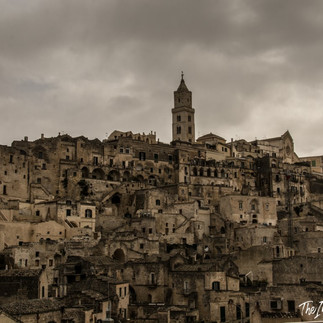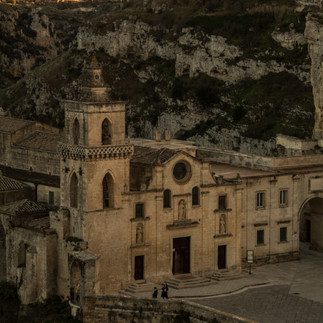
Region: Basilicata
Date: February 2022
Duration of visit: two days
My rating: 8/10
Technology has certainly revolutionized the world of travel and tourism in the last 20 years; not only has it facilitated the advent of low cost airlines, opening new travel opportunities to those who previously could not afford to travel and allowing everyone to travel with a frequency that was unthinkable until a few decades ago; not only has it given birth to millions of travel sites and blogs (too many huh? Did we really need another one?) that continually tickle the appetites of many new travel enthusiasts who until recently only contemplated their own sofa as a usual destination; an increasingly invasive role has been assumed by social networks and in particular by Instagram, where images, often artificial, continually invade billions of screens representing a more or less fictitious world where you can escape to "switch off", live a fairytale where for some days you feed the illusion that the dullness of the office in which you are relegated for too large a fraction of your existence is not, after all, reality, and that there is a better world out there. Among these reassuring and commodified images, repeatedly proposed in Instagram feeds, in addition to the sea turtle swimming lazily in a canal surrounded by palm trees and the classic bungalow on the water in the Indian Ocean, images of villages in stone have become a cliché. Regardless of whether the village is Breton, Norman, Basque or Tuscan, the stone village seems to correspond to an imaginary search for rurality, as a perfect and reassuring antithesis of the hyper-connected and ultra-competitive world in which much of Western civilization is forced, and among the stone villages, Matera, in recent years has acquired an out of the ordinary visibility and notoriety. In reality, the image of Matera had been well known for some time, even if perhaps in a relatively unconscious way; cinema aficionados have seen it for decades, starting with Pasolini's magnificent The Gospel According to Matthew
until Mel Gibson's The Passion consecrated the role of open-air film set of the Lucanian city, which has become the recurring home of Hollywood blockbusters, from Wonder Woman to 007 No Time to Die.
I don't mean to be an hypocrite, I too love wandering around the villages, whether they are Breton or Tuscan, to switch off and all this kind of thing ... but leaving for Matera I was moved by mixed feelings; on the one hand, the very high expectation for a place that, seen on Instagram in a thousand different angles, seemed to be an inexhaustible source of unprecedented views; on the other hand, the skepticism fueled by the awareness that too often Instagram promotes false, fake, sweetened images, artfully created to represent an ideal world and often not corresponding to reality.
I say it right away: Matera has met all expectations. It is magnificent, unique.

Matera is one of the places in the world permanently and continuously inhabited by humanity for the longest time. The first settlements date back to 15,000 years ago (these are 15 millennia we are talking about, not centuries ... we are talking about the Paleolithic!) and since then the places where Matera now stands have always been inhabited by some settlements and this, visiting Matera, is evident at every alley, at every corner. There are, in Italy, numerous splendid villages that are authentically ancient, and magnificent where unfortunately the beauty of the places and the authority of the past appear today a little faded in the face of the pressure of commercialization and intensive tourism (right now I am thinking of Pienza, which is amazing, but, from the ideal temple of humanism that it was meant to be, is now diminished into a shop for the display of Tuscan pecorini and fridge magnets); Matera is a village (actually a whole city!) which, despite not having the noble origins of Pienza, allows you to breathe history deeply, having not (yet) given way to wild tourism. How many other places in Italy, and in the world, allow to touch the slow evolution of history firsthand as in Matera, where the Palimpsest Early Christian frescoes, which appear almost everywhere, not only in rock churches, look like a parietal Spoon River of ancestors who lived 1,000 years ago?

It is difficult to think that a place that corresponds so closely to the current aesthetic canons, with its set of white stone alleys, baroque palaces, archaeological finds, could be considered, not too many decades ago, a model of neglect and shame. to the point that demolition was evaluated. Matera proudly exhibits its millennial history and now that, for years now, the resources for restoration and maintenance have begun to come, Matera shines as it probably has never done in tens of millennia.
I cannot say if it is just a transitory cultural situation, a trend that today, with a more uniform diffusion of well-being, brings the common sensitivity to the search for poor and rural roots; nor do I know how much, in Matera, they will be able to preserve this authenticity that is evident today, because around the city there is actually a noticeable diffusion, in every available place, of trendy restaurants with shabby chic sofas and signs in corten lloking all the same, so thatis natural to get a feeling of latent alarm at the thought that such an important historical heritage could be converted into an immense open-air restaurant within a decade. Currently the balance between commercial activities and conservation of the historical heritage is perfect and the necessary presence of shops and clubs does not invade or disturb to enjoy the place.
I must say it: the fact that, among the tourists who today visit the ancient cave houses, where a few generations ago families lived in 15 together with the animals, there might be some descendants of those same families who today, with smartphones and fashionable clothes, look with detachment from the conditions of extreme poverty in which people lived in this part of Italy just 60 years ago, gives me a feeling. in a positive sense, that in spite of everything, humanity and progress make their way, at least from the point of view of economic well-being and seeing that a cave house where the discharge of animal sewage was organized a short time ago is today a concert hall it makes me think that here it makes sense to talk about the "magnificent and progressive fate" that Giacomo Leopardi regarded with skepticism.

Another aspect, completely unexpected on my part, that I had overlooked, is the grandeur of the surrounding landscape and the "gravina", the canyon that winds all around the ancient city and probably induced the first inhabitants, millennia ago, to settle close to this extraordinary natural defense. In Matera I started my adventure, for now rather clumsy, as a drone pilot, and probably the following images do not do justice to the beauty of the places (it is already challenging to fly the drone without doing damage to things and people; to be able to doing it by capturing also aesthetically valid images is a skill that, perhaps, will come with time), but Matera combines, like few other places that I know, the natural beauty of the places with the historical and urban heritage.
A bit of history
Matera is a small city located in the Basilicata region, bordering the Apulia region and 250 km southeast of Naples.
The city is quite well known in Italy because it became a national political case in the postwar period. In fact, Matera has quite unique characteristics, since many houses in the historic center are in fact little more than caves carved into the rock; in the conditions of extreme poverty in which the local population of peasants lived in the years immediately following the Second World War, it had become a widespread practice for families, composed on average of over ten members, to live together with the animals in these caves where often all their life it took place in a single environment. An Italian writer, Carlo Levi, brought the matter to public attention and the Communist leader Palmiro Togliatti, followed by Prime Minister Alcide de Gasperi, the two main Italian political figures of the period, called Matera a "national shame". The state quickly decided to expropriate the houses in Matera and to transfer the population to modern houses.
A few years of neglect followed, after which Matera began to be sanitized and restructured; in more recent years Matera has gradually become a tourist attraction and the "sassi", literally "the stones", that is to say its quarters carved into the rock, have gradually acquired a significant real estate revaluation.

Travel tips
Nothing prevents you from dedicating even just a few hours to Matera to make contact with the city, but two days are the minimum to tour it properly, and I think that it is not even enough. I dedicated a weekend to Matera, landing in Bari early Saturday morning and leaving on Sunday at dinner time, and in these two days I managed to tour the city properly, taking all the time necessary to enjoy the places, visit some monument, eat in some restaurant, but in this way we have not visited all the main districts and we have just touched some of the main "rocky churches". It must be said that we have dedicated half a day (influenced in the choice by a splendid sunny day) to the trekking that descends into the ravine to go up on the opposite side, but I believe that, if the weather conditions allow it, it is an essential route to enjoy the view of the city from the plateau facing the city, the Murgia.
For the transfer from the Bari airport there are some private bus lines, which take about an hour. I used Miccolis and Cotrap; renting a car makes no sense, unless the visit to Matera is part of a wider tour of the area.
The official website of the tourism office of Matera is https://www.materawelcome.it/en/.

Many blogs and guides recommend favoring the Sasso Caveoso (the southern area of the "stones") where the houses dug into the rock prevail, compared to the Sasso Barisano, located in the north of the city, where built houses are more common than those excavated.. While it is true that, having little time, it makes more sense to visit at least one of the cave houses that are typical of Matera, I have not perceived such a clear distinction between the two districts and I believe that both deserve to be seen. Wandering through the streets of Matera you get the feeling that the city has developed randomly without a real urban planning; I confess that I have not investigated the matter, but it may be that this is due to the poor and peasant origins of the city; in any case, the continuous succession of foreshortenings and always different perspective planes is decidedly particular; this design seem to favor mainly the orography, rather than respond to an overall design. This succession of floors and volumes is from a visual point of view, the imprint of Matera and I think it would be a shame to renounce to stroll slowly around every alley and district, enjoying always new sceneries at every turn. If you are passionate about photography, bring a long focal length lens, because nowhere is the crushing of perspective as enhanced as here.
Add the Civita area to the two "stones", absolutely worth visiting, where the beautiful Duomo and the main noble palaces dominate the view of the city.
As already mentioned, another excursion that takes up half a day is the trek to the bed of the river that flows on the bottom of the ravine, to go up on the opposite side, where there are some caves inhabited by shepherds over the centuries and a plateau (the Murgia) from where you can enjoy a spectacular view of the Sassi. The route is feasible with simple sneakers and does not require particular training, but if you want to bring trekking shoes they could be useful in some slightly slippery passage.

The rupestrian churches deserve a separate chapter. Matera hosts more than 100 churches carved in the stone, most of which date back almost 1000 years. In two days we have just managed to see a few, all of extreme charm and historical value. Among the main ones I mention the Madonna della Virtù, Santa Maria de Idris, Santa Lucia alle Malve, the Crypt of the Original Sin (located outside Matera, requires a trip by car that we could not do) and San Pietro in Barisano.

My advice is to skip the "palombaro", the large water collection tank dug under the main square; it is recommended by almost all guides, but it is nothing more than a large hole in the rock; it may have required some engineering skills, but I didn't find it of any interest. In any case, if you are not afraid of the prospect of throwing away a few euros and a few minutes of time, you will not lose anything else.
From a culinary point of view, Matera has not given me any particular satisfaction. We visited some of the trattorias whose names appear in the main guides, but the Lucanian cuisine left us rather indifferent. The only thing that I believe deserves a mention is the "crusco pepper", a slightly sweet pepper, which is dried and is used both as an ingredient in many typical dishes, and as a snack between meals; it has a slightly burnt and rather particular sweetish taste; you will find them on sale everywhere in the shops of the city and even today, after months, when the thought runs to Matera, that is the flavor that awakens and that I associate with the place.



















































































































留言